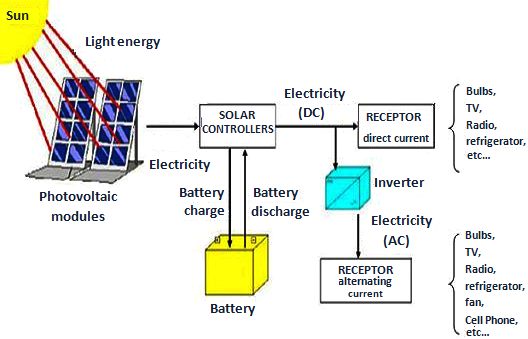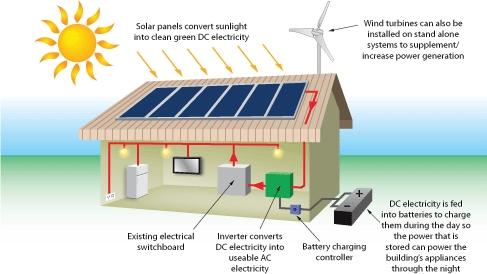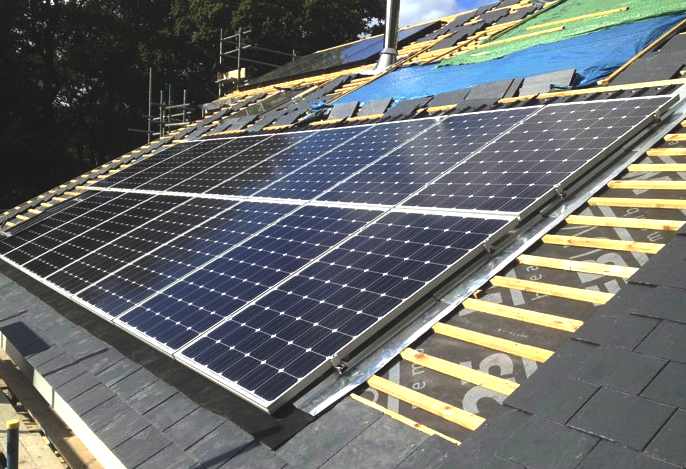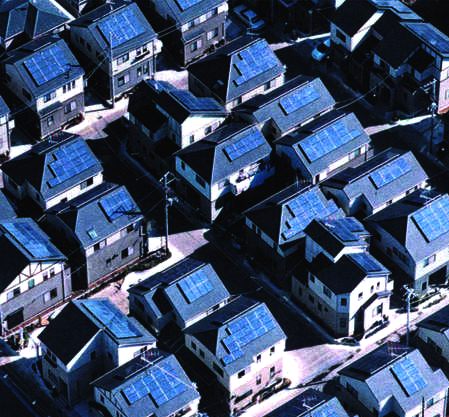|

You
have to have a roof, so integrate your energy harnessing needs to reduce
roofing costs. So many builders just put panels on top of tiles. That
way you are paying twice for weather proofing.
SOLAR
POWER REBORN SEPTEMBER 2013
LONDON
- In a move that may herald a return to large-scale solar development in the UK, Hampshire-based social housing association
First Wessex and Welsh renewable energy developer Dulas have agreed on a plan to put solar panels on 800 affordable homes across the
south of England.
Work will begin this month on the 2.5 MW, £4.3 million (€5.2
million) project, which will be completed within two years, said James Cass, business development and sales manager at
Dulas. Custom-made Hyundai solar panels will be used, he said.
According to social housing news site Inside Housing, many UK housing associations abandoned plans to install solar PV on their
tenants’ roofs after the feed-in tariff (FiT) was cut from 43.3 p/kWh to 21 p in late 2011, believing solar was no longer a viable
option. With the FiT cut, housing associations faced losses of up to
But the dramatic global fall in PV system costs since then – a drop of more than 50 percent – has enabled companies such as First Wessex
to make a new business case for solar.
“We were aware that [solar] prices had dropped, and we had long wanted to do something with PV,” said Paul Ciniglio, First Wessex's
sustainability and asset strategist. “We were one of the housing associations that didn’t move at the time tariff rates were at their
peak, but we were still keen to do projects.
"We tested the market through a tender excercise, which came back proving that solar is viable," he continued. While PV is "not as
lucrative as it was" before the FiT cut, he said, and “it’s still quite tight financially," it can work. "We put PV into our business
plan and were pleased to find that it would pay back sooner than expected, largely because of the reduction in supply and
installation costs," he said.
And for social housing associations the business case may involve more than profit. “We don’t really look at this purely as a
moneymaking exercise,” Ciniglio said. “Of course we’re looking at [a
solution] that does pay back for itself, but it also does a lot of good for our residents. For a housing association this should always
be part of the business case.” As well as reducing electricity prices for tenants who may be in fuel poverty, key to the choice of
Dulas was its plan to hire jobless young people from the community and teach them the solar business, Ciniglio said.
First Wessex expects its solar investment to pay for itself in 12 years, with a 9.3 percent return on a FiT rate of 14.9 p/kWh. After
the first 25 PV systems are installed, Ciniglio said, the rate will drop by 10 percent to 13.41 p/kWh because the company will then be
classified as a multi-system installer.
Housing associations could be in a good position to spearhead a return to PV due to their ability to leverage economies of scale.
First Wessex “looked at what we could get for our money,” said
Ciniglio, “and it was better than we thought it would be. Part of that is the quantity that we’re buying.”
The company did have a brief scare during the EU-China solar trade spat, he said. “Having got the tender back, there were anti-dumping
levies, so there was a time when module prices were increasing again,” he explained. “But we were able to find an alternative
product that [Dulas] could deliver at the original tender price by switching from monocrystalline to polycrystalline panels.”
Ciniglio said First Wessex has “had a lot of enquiries from local authorities and other housing associations, asking what we’ve done
and how it’s worked.” And development is underway: among others, Bristol City Council has undertaken what it says is the largest
solar project in the UK.
“The market needs a bit of confidence,” Ciniglio said. “When the FiT
got slashed people thought they’d missed the boat, it was too late, solar will never work now – but [this contract] proves that the
solar market is still open for housing association business.
“I would encourage [other housing associations] to test the market, go through a tender. If it still pays back, then why wouldn’t we do
it, really? You need to take a long-term investment decision, which is what we’ve done,” he said.
Cass believes that social housing will be a growth area for solar PV in the coming years. "In the next few years a lot more PV will be
made available on social houses via housing associations," he said. "PV has obviously been a volatile market to be in, but over the next
years more and more people will realise that roofs are an under-utilised resource. If you've got a roof, you may as well put
PV in place."
IS
FREE ELECTRICITY POSSIBLE?
It
is, but the payback time varies considerably, depending on location. In
the UK the payback time will be longer than most other countries. That
is why we recommend a mix of wind and PV harnessing, to reduce payback
and to be sure that when the sun is not shining, there is a back-up
method of generation.
WHAT
IS SOLAR POWER?
Solar power is the conversion of sunlight into electricity, either directly using photovoltaics (PV), or indirectly using concentrated solar power (CSP). Concentrated solar power systems use lenses or mirrors and tracking systems to focus a large area of sunlight into a small beam. Photovoltaics convert light into electric current using the photoelectric effect.
Commercial concentrated solar power plants were first developed in the 1980s. The 354 MW SEGS CSP installation is the largest solar power plant in the world, located in the Mojave Desert of California. Other large CSP plants include the Solnova Solar Power Station (150 MW) and the Andasol solar power station (150 MW), both in Spain. The over 250 MW Agua Caliente Solar Project in the United States, and the 221 MW Charanka Solar Park in India, are the world’s largest photovoltaic power stations.
SELF CONSUMPTION
In the case of self consumption the payback time is calculated based on how much electricity is not purchased from the grid. With net metering that is the total generated.
For example in Germany with electricity prices of 0.25 Euro/KWh and insolation of 900 KWh/KW one KWp will save 225 Euro per year, and with an installation cost of 1700 Euro/KWp the system cost will be returned in less than 7 years.
NET METERING
Net metering is particularly important because it can be done with no changes to standard electricity meters, which accurately measure power in both directions and automatically report the difference, and because it allows homeowners and businesses to generate electricity at a different time from consumption, effectively using the grid as a giant storage battery. As more photovoltaics are used, ultimately additional transmission and storage will need to be provided, normally in the form of pumped hydro-storage. With net metering, deficits are billed each month while surpluses are rolled over to the following month. Best practices call for perpetual roll over of kWh credits.[85] Excess credits upon termination of service are either lost, or paid for at a rate ranging from wholesale to retail rate or above, as can be excess annual credits. In New Jersey, annual excess credits are paid at the wholesale rate, as are left over credits when a customer terminates service.

A
basic PV home circuit, with a battery store
FINANCIAL INCENTIVE
The political purpose of incentive policies for PV is to facilitate an initial small-scale deployment to begin to grow the industry, even where the cost of PV is significantly above grid parity, to allow the industry to achieve the economies of scale necessary to reach grid parity. The policies are implemented to promote national energy independence, high tech job creation and reduction of CO2 emissions.
Three incentive mechanisms are used (often in combination):
investment subsidies: the authorities refund part of the cost of installation of the system,
Feed-in Tariffs (FIT): the electricity utility buys PV electricity from the producer under a multiyear contract at a guaranteed rate.
Solar Renewable Energy Certificates ("SRECs")

A
better arrangement with a wind turbine to increase capacity.
REBATES
With investment subsidies, the financial burden falls upon the taxpayer, while with feed-in tariffs the extra cost is distributed across the utilities' customer bases. While the investment subsidy may be simpler to administer, the main argument in favour of feed-in tariffs is the encouragement of quality. Investment subsidies are paid out as a function of the nameplate capacity of the installed system and are independent of its actual power yield over time, thus rewarding the overstatement of power and tolerating poor durability and maintenance. Some electric companies offer rebates to their customers, such as Austin Energy in Texas, which offers $2.50/watt installed up to $15,000.
FEED IN TARIFFS (FiT)
With feed-in tariffs, the financial burden falls upon the consumer. They reward the number of kilowatt-hours produced over a long period of time, but because the rate is set by the authorities, it may result in perceived overpayment. The price paid per kilowatt-hour under a feed-in tariff exceeds the price of grid electricity. Net metering refers to the case where the price paid by the utility is the same as the price charged.

Fitting
panels to an existing roof means taking up the slates and discarding
something you've already paid for. It is much better to fit solar panels
as part of the original roof of a house to save the cost of doing the
job twice. Cherry Homes is looking at how this might work combined with
our rooftop Solar Conservatories.
Solar Renewable Energy Credits (SRECs)
Alternatively, SRECs allow for a market mechanism to set the price of the solar generated electricity subsity. In this mechanism, a renewable energy production or consumption target is set, and the utility (more technically the Load Serving Entity) is obliged to purchase renewable energy or face a fine (Alternative Compliance Payment or ACP). The producer is credited for an SREC for every 1,000 kWh of electricity produced. If the utility buys this SREC and retires it, they avoid paying the ACP. In principle this system delivers the cheapest renewable energy, since the all solar facilities are eligible and can be installed in the most economic locations. Uncertainties about the future value of SRECs have led to long-term SREC contract markets to give clarity to their prices and allow solar developers to pre-sell/hedge their SRECs.
Financial incentives for photovoltaics differ across countries, including Australia, China, Germany, Israel, Japan, and the United States and even across states within the US.
The Japanese government through its Ministry of International Trade and Industry ran a successful programme of subsidies from 1994 to 2003. By the end of 2004, Japan led the world in installed PV capacity with over 1.1 GW.
In 2004, the German government introduced the first large-scale feed-in tariff system, under a law known as the 'EEG' (Erneuerbare Energien Gesetz) which resulted in explosive growth of PV installations in Germany. At the outset the FIT was over 3x the retail price or 8x the industrial price. The principle behind the German system is a 20 year flat rate contract. The value of new contracts is programmed to decrease each year, in order to encourage the industry to pass on lower costs to the end users. The programme has been more successful than expected with over 1GW installed in 2006, and political pressure is mounting to decrease the tariff to lessen the future burden on consumers.
Subsequently, Spain, Italy, Greece (who enjoyed an early success with domestic solar-thermal installations for hot water needs) and France introduced feed-in tariffs. None have replicated the programmed decrease of FIT in new contracts though, making the German incentive relatively less and less attractive compared to other countries. The French and Greek FIT offer a high premium (EUR 0.55/kWh) for building integrated systems. California, Greece, France and Italy have 30-50% more insolation than Germany making them financially more attractive. The Greek domestic "solar roof" programme (adopted in June 2009 for installations up to 10 kW) has internal rates of return of 10-15% at current commercial installation costs, which, furthermore, is tax free.
In 2006 California approved the 'California Solar Initiative', offering a choice of investment subsidies or FIT for small and medium systems and a FIT for large systems. The small-system FIT of $0.39 per kWh (far less than EU countries) expires in just 5 years, and the alternate "EPBB" residential investment incentive is modest, averaging perhaps 20% of cost. All California incentives are scheduled to decrease in the future depending as a function of the amount of PV capacity installed.
At the end of 2006, the Ontario Power Authority (OPA, Canada) began its Standard Offer Program (SOP), the first in North America for small renewable projects (10MW or less). This guarantees a fixed price of $0.42 CDN per kWh over a period of twenty years. Unlike net metering, all the electricity produced is sold to the OPA at the SOP rate. The generator then purchases any needed electricity at the current prevailing rate (e.g., $0.055 per kWh). The difference should cover all the costs of installation and operation over the life of the contract. On 1 October 2009, OPA issued a Feed-in Tariff (FIT) program, increasing this fixed price to $0.802 per kWh.
The price per kilowatt hour or per peak kilowatt of the FIT or investment subsidies is only one of three factors that stimulate the installation of PV. The other two factors are insolation (the more sunshine, the less capital is needed for a given power output) and administrative ease of obtaining permits and contracts.
Unfortunately the complexity of approvals in California, Spain and Italy has prevented comparable growth to Germany even though the return on investment is better.
In some countries, additional incentives are offered for BIPV compared to stand alone PV.
France + EUR 0.16 /kWh (compared to semi-integrated) or + EUR 0.27/kWh (compared to stand alone)
Italy + EUR 0.04-0.09 kWh
Germany + EUR 0.05/kWh (facades only)
JOIN
IN
Join
us in the drive for a green economy. Email
or call to register your interest in these exciting sustainable
developments for a better Britain.

STATE
OF THE ART
You
should note from all the systems looked at on this page, that none is an
integrated solution. They are all add-ons, or aftermarket accessories.
To be truly cost effective, such a system must form part of the design
of the house
LINKS
http://www.greenheatuk.co.uk/
http://www.solaire-photovoltaique.net/
Social-housing-associations-spearhead-uk-solar-renaissance
|




